After you’ve read this article, you’ll know how to clean and lubricate your bicycle’s chain, and why the chain wears in the first place.
For a detailed explanation of various chain oils (lubricant types) and their characteristics, read this (rather long) post: Bicycle chain lubricants – explained.
For a short recommendation, see: The best bicycle chain lubricant.
Table Of Contents (T.O.C.):
- Bicycle chain role (function)
- Bicycle chain wear (“stretch”) and sprocket/chainring wear
- When to replace a chain?
- Cleaning a bicycle chain
4.1. Jar with paint thinner
4.2. Special chain cleaning gadgets
4.3. Rag (and a brush)
4.4. Ultrasonic jewellery cleaner
4.5. Cleaning the other drivetrain components - How to lubricate a bicycle chain
- Which chain lubricant is the best
- When (how often) should a chain be lubricated?
TL/DR
Here, I’ve explained how you can best clean and lubricate your chan – and what to lube to use.
I first explained the chain’s construction and how it wears, but you can use the table of contents to quickly “skip” to the parts of interest.
1. Bicycle chain role (function)
Bicycle chain is used to transfer pedaling force to the rear wheel. It does so through at least two chainrings (front and rear), and sometimes derailleur. In order to work efficiently, it needs to match chainring teeth, as well as to bend smoothly. It is usually open, exposed to grit, moisture and pedaling forces. Because of all that, even when well maintained and lubed, chain wears gradually.
2. Bicycle chain wear (“stretch”) and sprocket/chainring wear
When a bicycle chain gets worn, visually it gives impression of being stretched, elongated. The elongation happens not because the chain steel is stretched, but because chain pins get thinner, worn. Detailed (and longer) explanation of the phenomena is in this post: Bicycle chain wear (elongation).
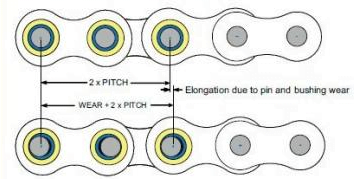
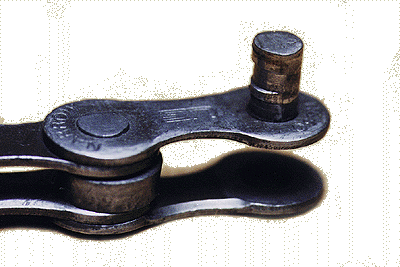
After chain elongation reaches a certain point, the chain starts climbing on the chainring (sprocket) teeth. The final stadium of this process is that only one or two teeth at a time carry the load, which accelerates chainring wear (as well as further chain wear).
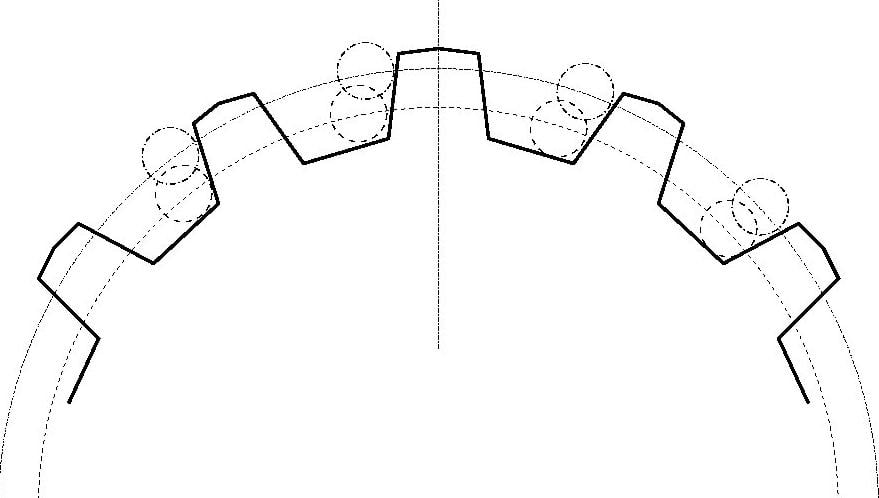
Because of this, if worn chain is not replaced in time, it will result in chain slipping off chainring teeth when under load (felt as pedals falling freely for short time when pedalling with force, or rear wheel slipping), perhaps even breaking, as well as probable full drivetrain replacement (both rear and front chainrings will quickly become worn when used with an elongated chain).
Rear sprocket wear is not (easily) visible (only with special measuring tools), but if a new chain “skips” over (some) sprocket(s), it is a sure sign of worn sprockets.
Worn front chainrings, on the other hand, are easily recognized. Teeth of worn chainrings look like saw teeth (or top shark fin), instead of being symmetric.

While worn rear sprockets tend to skip, worn front chainrings don’t, they in fact hold the chain a little too well – not releasing it at the bottom part of the chainring, pulling it up a bit. Effect known as “chain suck”.
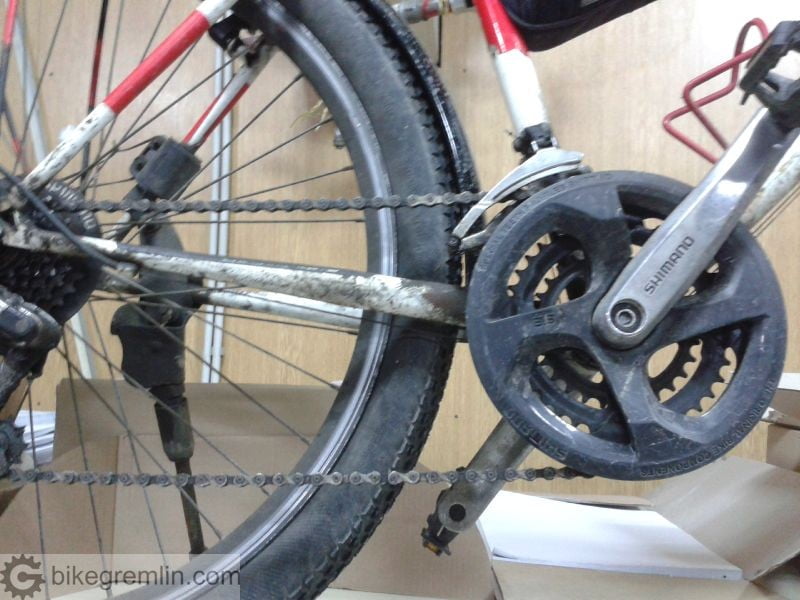

3. When to replace a chain?
Once the chain elongation reaches 0.5% of the nominal length, it is time to replace the chain. There are special chain wear measuring tools, but a simple ruler will also suffice. When measuring for wear, chain should be pulled tight and straight. Whether on the bicycle, or taken off.
Replacing the chain in time, allows rear sprockets to last from 2 to 4 chain replacements, without getting worn themselves. Front chainrings, even (lighter, but softer) aluminium ones, can last from 20 to 40 or more chain replacements.
For detailed explanation of chain wear and it’s measuring methods, as well as the consequences of irregular replacement, look at this post: When to replace the chain on a bicycle.
4. Cleaning a bicycle chain
Because bicycle doesn’t take very high loads, chain wear is mostly affected by two factors: lubrication and cleanliness. Outer appearance is not important, critical part is where rollers roll over the pins. It can even be said: chain life = cleanliness + lubrication. Both are equally important.
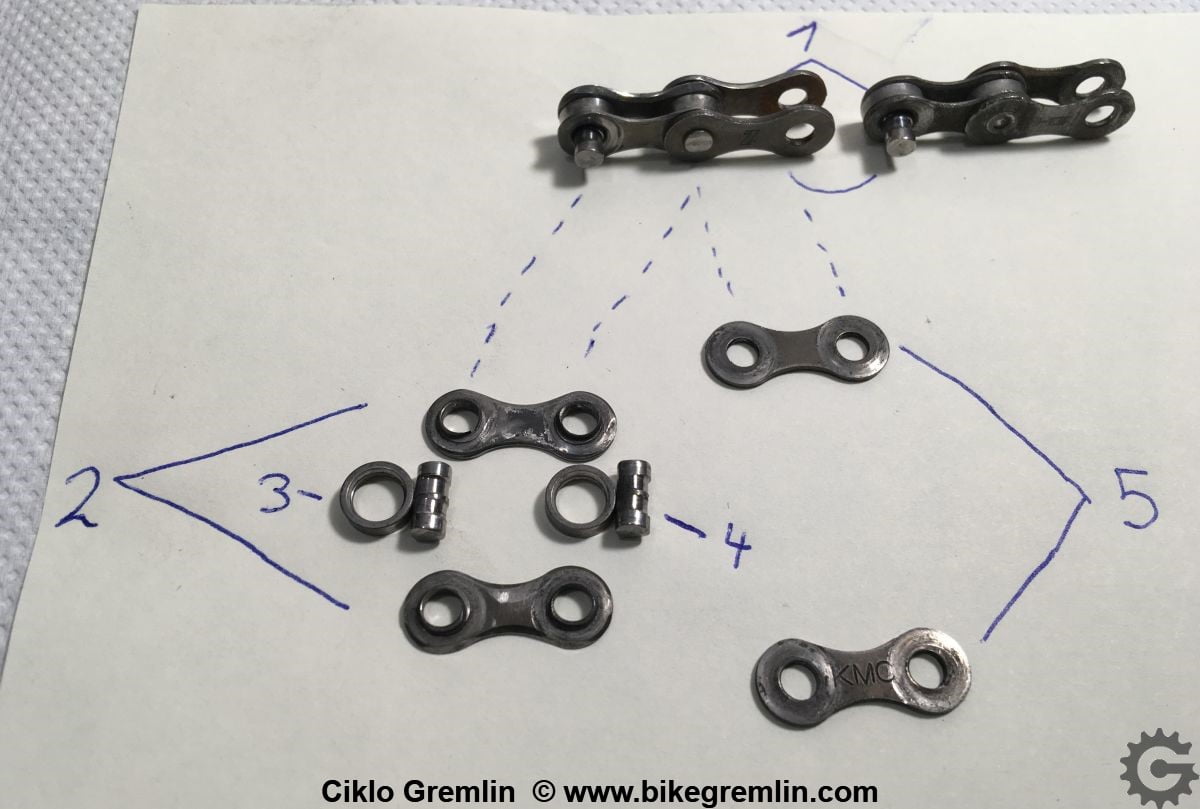
1: chain link
2: inner plate
3: roller
4: pin
5: outer plate
When dirt enters the space between the rollers and pins, it starts wearing the chain. Sanding (polishing) pastes are practically made by mixing sand and oil. That is why it is important that chain is as clean as possible (practical) before lubricating it. Following chapters will explain some common chain cleaning methods.
4.1. Jar with paint thinner
Chain is best cleaned by taking it off the bicycle, putting in a jar with some degreaser – oil paint thinner (i.e. odourless mineral spirits) is a great choice – closing the lid and then shaking it. Dirty liquid can be poured in another jar, later poured over a filter coffee filter, and used again – save the environment! 🙂
Then new degreaser is poured and the process is repeated, until the degreaser stops being dirty after vigorously shaking the chain in it. This means that (most of) the dirt between the rollers and pins was removed. If a chain appears clean on the outside, but after shaking the degreaser keeps getting dirty, it means there’s still dirt stuck between the rollers and pins – where it damages the chain.
For this cleaning method, it is best to use a so called quick connect link. Some chains come with this link (for example SRAM and KMC made chains usually do). For others a quick link can be separately bought – as long as it matches the number of speeds the chain is for. I.e. 8 speed link is needed for an 8 speed chain, 9 speed for a 9 speed chain and so on.
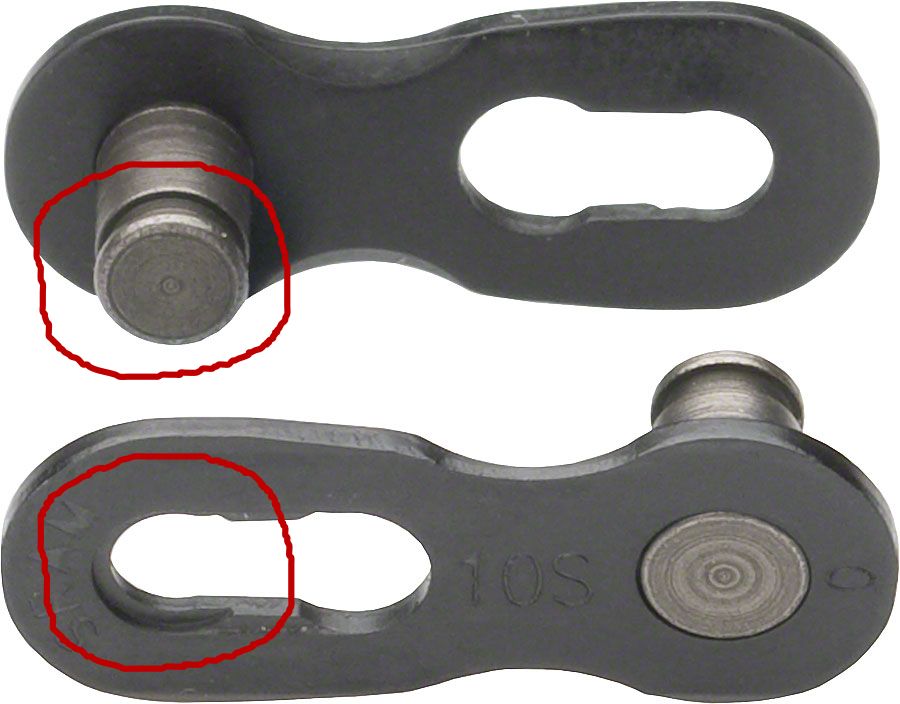
Pins of the link slide into the marked grooves, locking it in place
Chains for more than 8 speeds don’t have quick connecting links that can safely be re-used for numerous connecting and disconnecting of the chain! Chains for 9, 10, 11 and 12 speeds are more expensive, and need a new quick connecting link, or a new assembly pin when connecting them back after disassembling them. Chains for more than 8 speeds have thinner plates, so pins have smaller, weaker, groove to catch onto. That is why manufacturers don’t recommend re-using such quick links. They can hold after re-use, but can also disengage without a warning!
4.2. Special chain cleaning gadgets
They try to simulate method 4.1, only without the chain removal.

They usually spray a lot of dirt, dirt drips from the chain, but are less effective than the “jar” method.
4.3. Rag (and a brush)
Quick method for cleaning chain on the outside is using a rag with some degreaser. This method won’t clean between the rollers and pins. In fact, it can drive the dirt deeper into the chain, although it will appear clean on the outside.
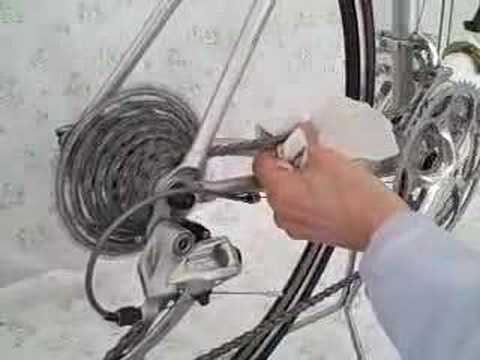
Advantage of this method is that it’s the fastest, with the least amount of dirt spread around, so those who favour time saving to chain life can use it.
Those who want to make it more messy, with questionably better effect, can use an old tooth brush with some degreaser as well and rub the chain.
4.4. Ultrasonic jewellery cleaner
The opposite of the “rag” method. The name says it all.
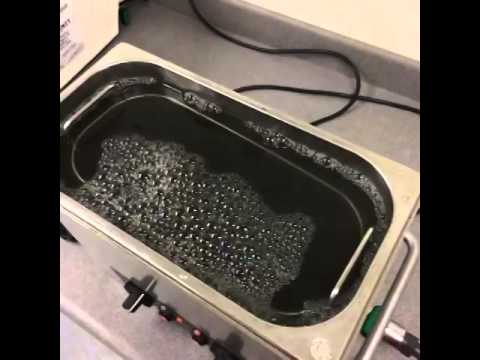

4.5. Cleaning the other drivetrain components
Clean chain will quickly get dirty if put over a dirty chainring, with lots of sand stuck to it. That is why, when cleaning a chain, it is also important to clean the rest of the drivetrain as well.


All the cleaning methods shown above do not exclude one another, they can complement each other. Depending on one’s preferences and priorities.
5. How to lubricate a bicycle chain
Proper way to lubricate a bicycle chain is this: one drop of lubricant on each roller, on the inside. It is important for the lubricant to flow between the rollers and pins.
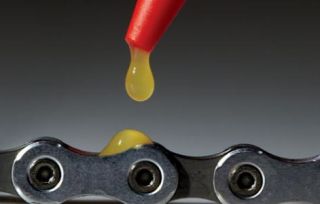
Afterwards spin pedals for about a minute, in order for the lubricant to spread evenly, between rollers and pins. Then use a cloth to wipe all the excess oil from the chain (method explained in chapter 4.3.). The outside of the chain should be (almost completely) dry – with lubricant only left between the rollers and pins.
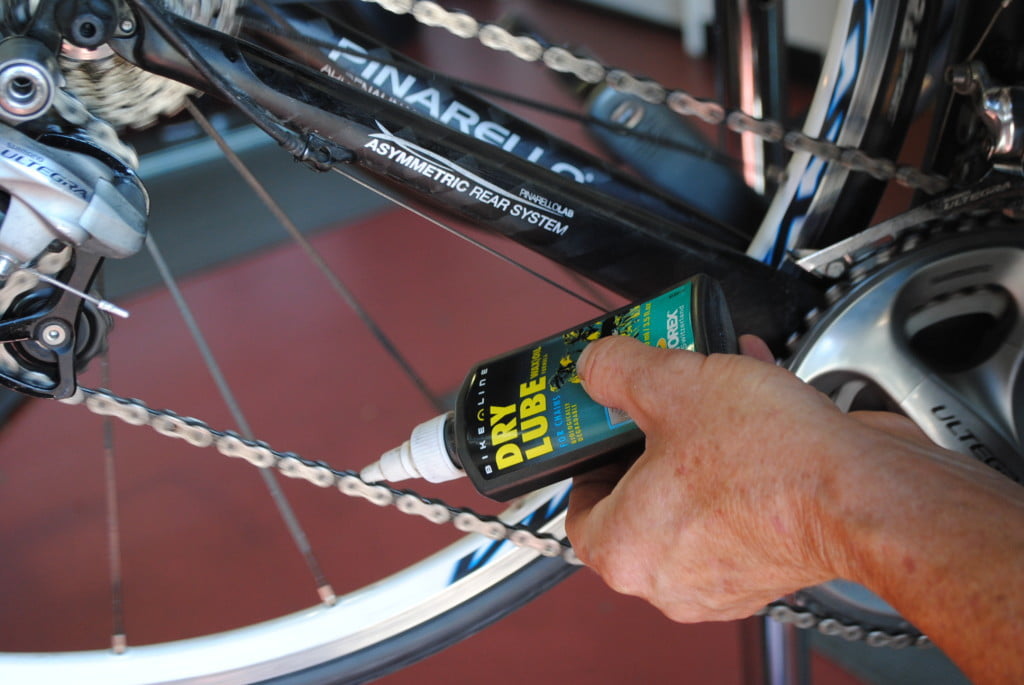
There are also special dry lubricants. Usually paraffin wax based. They require a completely clean and dry chain before applying. Advantage is they are dry, so the chain doesn’t get dirty, sticky as with wet lubricants. Disadvantage is they are less resistant to rain washout.
Some even like to remove their chain, dip it in molted paraffin wax, or grease, then let it drip, wipe excess off and reinstall. This requires a bit more time and effort.
I’ve explained how it’s done in this video (without thorough cleaning using some degreaser on the cloth, just explained the principle):
6. Which chain lubricant is the best?
This question will, a bit rudely, be answered with another question: which bicycle is the best? A mountain bike will “shine” in the mud, but on a paved road it will be blown away by a road bike – and vice-versa.
It all depends on one’s riding conditions, chain cleaning methods and preferences. Generally, lubes that resist rain washout well, usually attract a lot of sand and dust – and vice-versa. If using a “wet” (oil based) lubricant – the “thicker” it is, the more it will resist water washout, but attract more dirt.
Author of this text usually uses either motor oil, or chain saw bar oil, diluted in diesel fuel to achieve required “thickness” – for autumn pouring rain, I prefer thicker oil. For deep freezing temperatures, fully synthetic “winter” petrol engine oil is a decent choice.
Sewing machine oil is also a decent choice. There are numerous lubricants sold as special, bicycle chain lubrication specific. Usually (a lot) more expensive. Some even work very well.
Motorcycle chain sprays? This gets asked a lot, so it’s worth answering. Motorcycle chains spin with huge velocities. So motorcycle chain sprays often contain silicone, or some other additive to make the lubricant more sticky and “thick”. This is detrimental for cycling use, because such lube will attract a lot more dirt. No matter how fast one spins the pedals, their bicycle chain will never get to such a high velocity to just throw oil off. So I would say that most motorcycle chain spray lubricants are a bad idea for bicycle chain lubrication.
Bicycle chain lubricants in spray cans? Unlike motorcycle chain lubricants, these are generally OK. They cost a lot more compared to what I’d call the best bicycle chain lubricant, and you are more likely to spray the adjacent stuff (like brake pads, or discs – pay attention). However, as far as chain lubrication and cleanliness is concerned, they are good.
Comparison of various chain lubricants is given in the post: Comparative overview of bicycle chain lubicants:

7. When (how often) should a chain be lubricated?
The chain starts making a distinct sound when it’s not lubricated.
OK, it will literally squeak when it’s completely dry, but if there’s at least a minimal amount of lubricant, the sound will be different. How can I describe this? Very fine rattling.
After you’ve lubricated your chain, and done some riding, you will most likely notice when your chain becomes noisy.
How many miles?
It depends on the type of chain lubricant you are using, and your riding conditions. For example: if you are using a “thin” (low viscosity) chain lubricant, or a dry lubricant (wax-based), the chain will start making noises after just one 5-mile ride in heavy rain.
The opposite extreme is using a very thick lubricant (high viscosity) and riding in dry conditions. In this case you’ll have problems with a lot of dirt and sand getting stuck to the chain, but it will take many miles before it needs re-lubricatin (though it would be a good idea to clean it and use a thinner lubricant).
Generally speaking: you can lube your chain every 100 miles, or so. A bit more often if you use dry, or very thin lubricants, or ride in the rain, and a bit less often if you ride in dry conditions without much dirt, or sand.

New chains come greased from the factory. I couldn’t find the formula for the factory grease, but it is very long-lasting and doesn’t attract much dirt. That’s why it is not wise to clean/lube a new chain. It should be just wiped on the outside (to remove any outer grease that could attract dirt), mounted and ridden until it starts making noise – and that can take a while with the factory grease.
The existing comments posted under this article (questions and answers) have been moved to this BikeGremlin forum thread:
https://www.bikegremlin.net/threads/how-to-lubricate-a-bicycle-chain-article-comments.129/

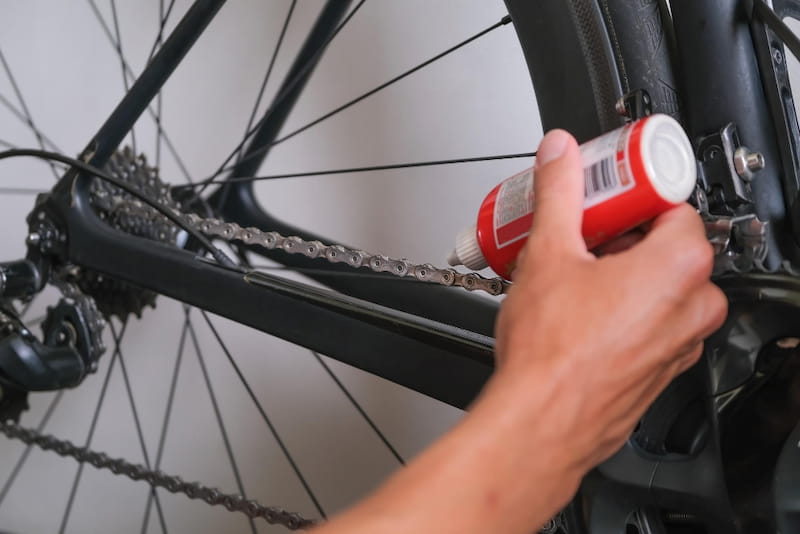
i really like shimano chains,they are very well designed,my favorite chains are shimano hg chains,however i do not like the factory grease in shimano chains,it turns into a sticky black mess and attracts too much dirt,friction facts testing and zero friction facts cycling professional testing on all chains and lubes shimano factory grease was not recommended,both these sites did chain friction test,they also put chains through long term testing on purpose built chain and lube testing machine,at the end of all the lube testing they only recommended about 8 wax based lubes for less chain wear and long lasting lubes,as far as i know Adam from zero friction cycling and Jason Smith who was from friction facts are the only guys world wide who conducted very professional lube testing on most commercial based lubes,my personal chains with shimano factory grease allways performed badly and i now remove it from a brand new shimano chain as it turns into a sticky black mess within days of riding and it turns into a dirty grinding paste,very extensive chain lube testing put mainly wax based lubes as the best performers,straight parafin wax and molten speed wax got the top of the list,you can find all the modern lubes they tested as each test was fully documented and still available if you look up Jason Smith who was friction facts who later sold it to ceramic speed,and Adam is an aussie from zero friction cycling who still tests chain lubes if you would care to send him a modern chain lubes,his testing is very extensive and only uses the scientific data that he gathers from the lube testing,he does dirt testing on lubes,chain pin wear on lubes,longlife testing on lubes,Adam also is the guy that markets molten speed wax in aussie land
Hi Mike,
Regarding the chain lubricant tests you mentioned:
They didn’t include gear shifting in their testing (i.e. multi-sprocket bikes, with a chain that gets angled when switching between the front and rear chainrings). Wax, unlike oil, doesn’t flow back when dislocated from an area. Doesn’t replentish it. And it’s a lot more susceptible to water washout.
So, depending on one’s mainenance schedule and riding conditions, wax may not be the perfect candidate. The longer a ride, and the more rain there is, the more I prefer oil-based lubricants. While the wax based ones are a good choice for dry and/or sandy/dusty conditions. At least in my opinion & experience.
wax is not the best wet weather lube i totally agree with you there Relja but in australia where its mainly hot dry and dusty conditions its the perfect choice,as for wax it performs the best at keeping dirt out of the chain,in the long run its mainly dirt and grime that ruins a chain fast,this is where wax lubes shine,no grit or muck in chain as the wax keeps shedding and throws the grit out,lubrication wise wax is the smoothest drive chain i have ever used,in wetter climates would not be such a good idea for wax based lubes,i like using wax now as i dont get black grime everywhere,and as for a home made cheap lube parrafin is a real good option,i was suprised that there were only two guys in the whole world that put modern chain lubes to extensive testing,the main testing they did was to see what affect all lubes had on chain pin wear and how long the lubes lasted before there was significant pin wear thats what causes chains to mainly fail.cheers
That makes sense, Mike. And yes, dirt is one of the things that rapidly increase chain wear. However, lack of lubricant is another problem that can kill a chain even more rapidly (a dry chain on a climb can break during one ride). The tests you mention didn’t include any shifting, thus I don’t think they are relevant for wax based lubes on multi-chainring bikes, as the chain gets at different angles there, pushing the wax aside, and wax, unlike the oil-based lubricants, doesn’t flow back to lubricate the contact areas. Had they included some lateral movement of the chainrings during the test, it would have been a lot more realistic in my opinion.
Having said all that, for dry conditions, especially if rides (intervals between lubrication) aren’t longer than 100 Km, wax is a very good choice.
Hi Relja,they did include rear mech shifting on later testing,on alot of modern lubes and various types of waxes,the testing they did was very professional,they ran each lube and each chain until the chains wore out,i doubt if anyone else has put chains through this extensive testing,the testing was backed by the sientific data they collected,it was not market spinning,jason smith was the first to do these extensive tests,now adam from molten speed wax still does these tests on most common lubes on the market,paraffin wax based lubes among the best lubes tested,even straight food grade paraffin wax,example,gulf wax or similar food grade paraffin got the top of the list for the least chain pin wear after the tests,i am now testing candle wax and food grade straight paraffin wax and i really like the results,no more dirty black chains and my system is definatly running alot smoother just using paraffin wax with nothing else,i dont see any reason to add anything else with the paraffin wax as its a good lube just on its own,just hot dip your chain in melted paraffin wax on the stove in an old saucepan,no need to go buy any fancy gear.
Hi Mike,
Do you know where I could find the published tests and results that included derailleur shifting?
I’m interested in reading about the methodology and the test results.
most folk use food grade paraffin wax for chains as this is the most refined wax with very little oil content in it,this is a slighty harder wax then normal candle wax,there are quiet a few types of paraffin,candles have a higher oil content and they will do the job but they gunk up the chain more,food grade paraffin runs alot cleaner but i still think paraffin is a good lube just on its own with nothing added,some do add ptfe fine powder with it for race days
alot of bicycle shops are now selling pre-waxed brand new chains,here is hoping shimano starts doing waxed nickle plated chains,i cant work out why shimano has not allready made some,they could do a waxed chain with every series of hyperglide chains
Hi Relja,if you jump on youtube and go and look at zero friction cycling you will see all the results,Adam goes into great depth on the subject,he also responds to questions if you have any,he does also still test most modern chain lubes,he has been doing this for along time now,I dont know of anyone who has done his type of testing,i think he also tests lubes for some companies cheers and all the best for the new year Relja,may all your dreams come true,and thank you for the past year and helping me out with bicycle stuff cheers
Hi Mike,
I visited their website with the friction and chain durability with various lubricants tests.
There is no shifting noted in the test methodology.
Happy holidays and all the best in the New Year to you Mike. 🙂
chain waxing with paraffin wax is a very cost effective way to lube your own chains,after the first cleaning you have to strip away all that muck and grease with solvents but after that the next time you wax you just put the chain into a pot of paraffin,no need to even clean the chain first,if there is any dirt it sinks to the bottom of the pot of hot wax,its by far the least time consuming method after that first cleaning,very little dirt comes off the chain the second time you wax and the chain stays pretty clean,it would be better to do the waxing on a higher end nickle plated chain due to cheaper chains having very little corrosion protection,if you live in dry dusty place then you wont find anything better than waxing,it runs very smooth and chain stays pretty clean,shifting is very good and no problems there,i have never had any chain run as smooth as a wax,the work involved cleaning a wet lube chain is alot longer and you never seem to get rid of all that dirt and black grease unless you dip chain in a solvent,you can buy a l kilo of food grade paraffin from most candle suppliers,if not amazon and ebay has plenty,there is also quiet a few ready made options,like molten speed wax,silca secret wax,and another one called badger wax,that one is paraffin wax with ptfe added,it retails for about $15 for 1/2 a kilo,also some bicycle shops are now selling ready made waxed chains,if you have not tried waxing yet i would give it a try if you live in dry dusty place,buy one kilo of food grade paraffin and thats alot of lube cheap for the whole year and you could dip in 3 chains at once and thats the beauty of using paraffin wax,it work quiet well and alot of riders are getting over 10,000 on one chain before it wears past 0.5 mark,wet lubes are lucky to get past 3,000 as dirt gets in your chain rollers and it stays in there acting like sandpaper
Hi Relja,the test were done with a modern 11 speed cassette and definatly included shifting,cycling tips website and velo news website has some very good articles on the chain testing,also the chain lube tests are pretty much all over the web,not only did the the testing include chain pin wear it also included chain roller wear and they also tested chains corrosion properties while testing,water was sprayed at the chains,dirt was sprayed at the chains,it was the closest thing you can get to real world testing in a controlled test,it was,the top lubes in later testing was molten speed wax,squirt, plain paraffin wax and smoove was highly reccomended,how long the lubes lasted was also tested along with how well they performed in dirt and water,paraffin wax with ptfe powder got very impressive results
if you use a waxed chain on your indoor bike trainer and dont like the wax flying off you can bind it together using part paraffin wax and part microcrystalline paraffin wax as the microcrystalline wax acts like a slight adhesive and keeps the wax together but you dont need very much of the microcrystalline wax as it can get very tacky like natural beeswax it will also soften any grade paraffin wax,or just try a softer paraffin there are different grades of softness,40J,50J,60J,a softer soy type wax could also be mixed with the paraffin,and i am sure there would be other products to soften the paraffin as well,most of the harder paraffins to tend to break up and fly off the chain,so you need to go softer without going too tacky or oily
just a little update to the paraffin wax for bike chains i tried a slightly harder wax,that one was a japan made wax,it sells in australia as 60J food grade paraffin in one kilo blocks at most candle suppliers,that wax does flake off abit,but still runs well,then i tried a lower melting point food grade paraffin wax being 50J and this one seems alot better and it is more slippery and hardly flakes much being a slighty softer wax,each time i dip my chains in melted wax only a few specs of dirt comes out of the chain and drops to the bottom of the pot,my chains stay amazingly clean and smooth running through the gear shifts,i still dont see any point in adding anything else to the paraffin wax as its a fantastic lube just on its own,if you did add anything else to it like graphene or ptfe i think they would only be very marginal gains and it would make the process more expensive.put your stove on the lowest possible setting to melt the wax,no need to get it super hot as if fumes are rising from the pot its way too hot,it can actually catch on fire,paraffin wax does have a flash point,put in your chain just as soon as all wax is melted,leave it in there for about 15 minutes with stove now turned off then you dont pull the chain out until the wax starts to form a skin,that way it does not run all over the place and the wax stays inside those rollers and on the outside of chain,do not wipe the chain at all,just hang it up to dry on a wire coathanger,the chain will be ready to use in 1/2 an hour when the links go abit stiff,then you run the chain around a piece of wooden dowel or simliar to break the links,in the first ride leave for about 5 minutes to start shifting as after that you will get very nice shifting and the smoothest chain you have ever used,i am yet to do more wet weather and longer term testing on my older hg40 chains.so far i cannot find any negatives about a waxed chain